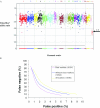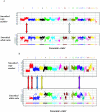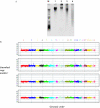Allele quantification using molecular inversion probes (MIP)
- PMID: 16314297
- PMCID: PMC1301601
- DOI: 10.1093/nar/gni177
Allele quantification using molecular inversion probes (MIP)
Abstract
Detection of genomic copy number changes has been an important research area, especially in cancer. Several high-throughput technologies have been developed to detect these changes. Features that are important for the utility of technologies assessing copy number changes include the ability to interrogate regions of interest at the desired density as well as the ability to differentiate the two homologs. In addition, assessing formaldehyde fixed and paraffin embedded (FFPE) samples allows the utilization of the vast majority of cancer samples. To address these points we demonstrate the use of molecular inversion probe (MIP) technology to the study of copy number. MIP is a high-throughput genotyping technology capable of interrogating >20 000 single nucleotide polymorphisms in the same tube. We have shown the ability of MIP at this multiplex level to provide copy number measurements while obtaining the allele information. In addition we have demonstrated a proof of principle for copy number analysis in FFPE samples.
Figures











Similar articles
-
Genome-wide copy number alterations detection in fresh frozen and matched FFPE samples using SNP 6.0 arrays.Genes Chromosomes Cancer. 2008 Nov;47(11):957-64. doi: 10.1002/gcc.20599. Genes Chromosomes Cancer. 2008. PMID: 18663747
-
Optimization of the Affymetrix GeneChip Mapping 10K 2.0 Assay for routine clinical use on formalin-fixed paraffin-embedded tissues.Diagn Mol Pathol. 2008 Mar;17(1):3-13. doi: 10.1097/PDM.0b013e31815aca30. Diagn Mol Pathol. 2008. PMID: 18303412
-
Whole genome SNP arrays using DNA derived from formalin-fixed, paraffin-embedded ovarian tumor tissue.Hum Mutat. 2005 Oct;26(4):384-9. doi: 10.1002/humu.20220. Hum Mutat. 2005. PMID: 16116623
-
Molecular inversion probes: a novel microarray technology and its application in cancer research.Cancer Genet. 2012 Jul-Aug;205(7-8):341-55. doi: 10.1016/j.cancergen.2012.06.005. Cancer Genet. 2012. PMID: 22867995 Review.
-
Improved microRNA quantification in total RNA from clinical samples.Methods. 2010 Apr;50(4):S6-9. doi: 10.1016/j.ymeth.2010.01.006. Methods. 2010. PMID: 20215018 Review.
Cited by
-
Genome-wide detection of human copy number variations using high-density DNA oligonucleotide arrays.Genome Res. 2006 Dec;16(12):1575-84. doi: 10.1101/gr.5629106. Epub 2006 Nov 22. Genome Res. 2006. PMID: 17122084 Free PMC article.
-
Integrative genomic profiling of human prostate cancer.Cancer Cell. 2010 Jul 13;18(1):11-22. doi: 10.1016/j.ccr.2010.05.026. Epub 2010 Jun 24. Cancer Cell. 2010. PMID: 20579941 Free PMC article.
-
Ultra-sensitive monitoring of leukemia patients using superRCA mutation detection assays.Nat Commun. 2022 Jul 12;13(1):4033. doi: 10.1038/s41467-022-31397-y. Nat Commun. 2022. PMID: 35821208 Free PMC article.
-
A molecular inversion probe assay for detecting alternative splicing.BMC Genomics. 2010 Dec 17;11:712. doi: 10.1186/1471-2164-11-712. BMC Genomics. 2010. PMID: 21167051 Free PMC article.
-
Genomic characteristics of trastuzumab-resistant Her2-positive metastatic breast cancer.J Cancer Res Clin Oncol. 2017 Jul;143(7):1255-1262. doi: 10.1007/s00432-017-2358-x. Epub 2017 Feb 28. J Cancer Res Clin Oncol. 2017. PMID: 28247034 Free PMC article.
References
-
- Pui C.H., Relling M.V., Downing J.R. Acute lymphoblastic leukemia. N. Engl. J. Med. 2004;350:1535–1548. - PubMed
-
- Slamon D.J., Leyland-Jones B., Shak S., Fuchs H., Paton V., Bajamonde A., Fleming T., Eiermann W., Wolter J., Pegram M., et al. Use of chemotherapy plus a monoclonal antibody against HER2 for metastatic breast cancer that overexpresses HER2. N. Engl. J. Med. 2001;344:783–792. - PubMed
-
- Kallioniemi O.P., Kallioniemi A., Sudar D., Rutovitz D., Gray J.W., Waldman F., Pinkel D. Comparative genomic hybridization: a rapid new method for detecting and mapping DNA amplification in tumors. Semin. Cancer Biol. 1993;4:41–46. - PubMed
-
- Pinkel D., Segraves R., Sudar D., Clark S., Poole I., Kowbel D., Collins C., Kuo W.L., Chen C., Zhai Y., et al. High resolution analysis of DNA copy number variation using comparative genomic hybridization to microarrays. Nature Genet. 1998;20:207–211. - PubMed
-
- Pollack J.R., Perou C.M., Alizadeh A.A., Eisen M.B., Pergamenschikov A., Williams C.F., Jeffrey S.S., Botstein D., Brown P.O. Genome-wide analysis of DNA copy-number changes using cDNA microarrays. Nature Genet. 1999;23:41–46. - PubMed
Publication types
MeSH terms
Substances
LinkOut - more resources
Full Text Sources
Other Literature Sources
Research Materials

